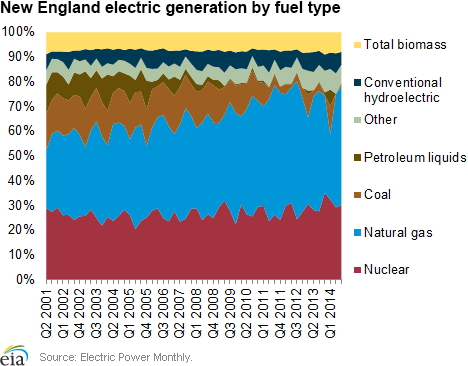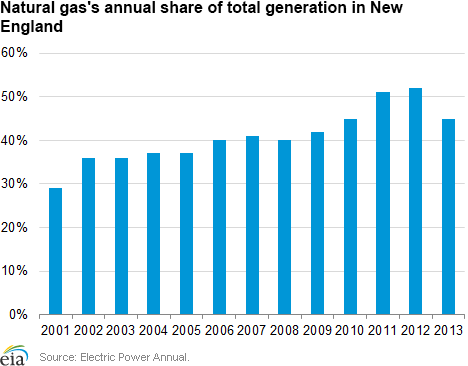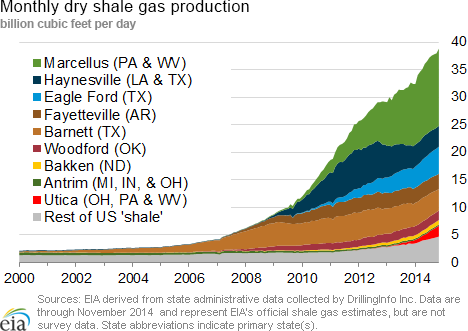In the News:
Vermont Yankee nuclear plant closure could add gas demand
Entergy Corporation’s Vermont Yankee 604-megawatt (MW) nuclear power plant retired last week, after 42 years of service. The closure of the generating station, which provided about 4% of the region’s electricity sales, will increase New England’s dependence on natural gas for power generation, according to the Independent System Operator of New England (ISO-NE), the region’s wholesale power market operator. EIA estimates that natural gas electric power generation capacity of a similar size to Vermont Yankee could burn about 100 million cubic feet per day (MMcf/d) of natural gas.
Entergy cited low wholesale prices, high costs of maintenance, and low prices in regional markets for electric generating capacity as reasons for closing Vermont Yankee.
Nationally, other nuclear power plants have announced their retirement in the past few years because of high maintenance costs and declining profitability. Three years ago, in California, the San Onofre Nuclear Generating Station (SONGS) was shut down following a leak, and operator Southern California Edison concluded it would not be economic to spend a huge sum to fix the two operating units. The politically controversial SONGS had been producing 2,150 MW of power.
Nonnuclear facilities in New England have also retired or announced their intent to shut down. Dominion Energy Resources retired its nearly 750-MW Salem Harbor coal- and petroleum-fired power plant in Massachusetts in June 2014. Dominion cited a combination of the costs of compliance with new environmental regulations as well as declining profits for coal-fired units in New England. Future shutdowns include the 1,520-MW Brayton Point coal- and natural-gas/oil-fired power plant in Somerset, Massachusetts, expected to be shut down in 2017.
Natural gas has increased as a share of fuel for power generation in New England over the past several years, rising to 52% in 2012 when natural gas prices reached record lows. In 2013, natural gas’s share of generation fell to 45%, but was still much greater than in previous years. In addition, ISO-NE said in its regional system plan that more than 4,500 MW of natural gas capacity and 3,700 MW of wind capacity has been proposed, as more retirements are expected in the next few years.
In addition to adding generation capacity, northeastern utilities and Hydro-Quebec have proposed constructing several transmission lines, including the 1,200-MW Northern Pass, to increase transmission of electricity from Canada. Hydro-Quebec has more than 36,000 MW of installed hydroelectric capacity and has been exporting electricity to New England and New York since the 1980s.
Overview:
(For the Week Ending Wednesday, January 7, 2015)
- Natural gas spot price movements were mixed across the United States because of warmer weather in the western half of the country and colder weather east. With mild weather, prices fell slightly in the West. In the rest of the country, prices increased as temperatures dropped during the report week (Wednesday to Wednesday). The Henry Hub spot price increased from $3.00 per million British thermal units (MMBtu) last Wednesday, December 31, to $3.07/MMBtu yesterday.
- At the New York Mercantile Exchange (Nymex), the February 2015 contract fell slightly by $0.018/MMBtu from Wednesday-to-Wednesday, beginning the report week at $2.889/MMBtu last Wednesday and ending at $2.871/MMBtu yesterday.
- Working natural gas in storage decreased to 3,089 Bcf as of Friday, January 2, according to the U.S. Energy Information Administration (EIA) Weekly Natural Gas Storage Report (WNGSR). A net withdrawal from storage of 131 Bcf for the week resulted in storage levels 8.8% above year-ago levels and 2.1% below the five-year average for this week.
- The total U.S. rotary rig count decreased by 29 units to 1,811 rigs for the week ending January 2, according to data from Baker Hughes Inc. The natural gas rig count decreased by 12 units to 328, while oil rigs decreased by 17 units to 1,482. One miscellaneous rig remained in service.
- The Mont Belvieu natural gas plant liquids composite price fell by 6.0% to $5.15/MMBtu for the week ending January 2. With the exception of ethane, which closed up 5.3%, all other component prices fell this week. The prices changed as follows: natural gasoline, -7.3%, propane, -11.2%, butane, -4.8%, and isobutane by -4.2%.
Prices/Demand/Supply:
Price movements are mixed nationally because of regional weather conditions. While the western half of the country experienced warmer-than-normal temperatures and modest natural gas price decreases, colder winter conditions in the rest of the country drove up demand and prices. Despite higher Southeast demand, Henry Hub in Louisiana started the week at $3.00/MMBtu, fluctuated, and closed the week up only slightly yesterday at $3.07/MMBtu.
Northeast spot prices rise through the week. Temperatures fell into the single digits in the Midwest and Northeast, and below zero wind-chill occurred in these regions. In the Northeast, prices at some major locations doubled, tripled, or increased five-fold through the report week. Prices at Transcontinental Zone 6 New York started the report week at $3.16/MMBtu last Wednesday and climbed to over $17/MMBtu on Tuesday, before closing yesterday at $13.75/MMBtu. At the Algonquin Citygate, with service to Boston, prices started the report week at $5.86/MMBtu and closed yesterday at $12.54/MMBtu. Price responses in the Midwest were a bit more moderate. Prices at the Chicago Citygate increased by 10% Wednesday-to-Wednesday, closing yesterday at $3.35.
Marcellus-area prices remain below $1.50/MMBtu during most of the report week. After dipping below $1/MMBtu on Friday’s close, trading points for Marcellus/Utica production closed higher for the report week. Prices at Tennessee's Zone 4 Marcellus, Transcontinental's Leidy Line trading point, and Dominion South, closed yesterday at $1.42/MMBtu, $1.37/MMBtu, and $1.38/MMBtu, respectively.
Nymex February contract price falls over the report week. After opening the report week at $2.889, the February futures contract price climbed to $3.003/MMBtu on Friday, but ended the report week down 2 cents, closing yesterday at $2.871/MMBtu. The 12-month strip, the average of February 2015 through January 2016 futures contracts, ended the week down 6 cents, at $2.901/MMBtu.
U.S. dry gas production drops during the report week. Dry gas production slowed from its recent record pace to fall below 70 billion cubic feet per day (Bcf/d), off 2.7% from last week, according to data from Bentek Energy. There were reports of production freeze-offs in West Texas and the Permian, which contributed to the reduced production. Despite this decrease, dry gas production remained 9.6% above last year’s production level for the same week.
Imports increase during the report week. Imports of natural gas from Canada increased 21.9% for the week, reaching close to 8 Bcf/d, the highest level of imports from Canada since January 2014. Sendout of liquefied natural gas (LNG) reached levels that have not occurred in recent history. LNG sendout was close to 2 Bcf, yesterday, the highest volume of LNG sendout since April 2011. Although sendout from Maryland’s Cove Point LNG import facility contributed the most to yesterday’s total, small volumes were also delivered from the Northeast Gateway floating LNG facility, off the coast of Massachusetts, marking its first delivery since March 2010, according to Bentek Energy data.
Demand increases as temperatures drop. Yesterday, U.S. natural gas consumption climbed to 129 Bcf/d, its highest level since January 2014, and the fifth highest recorded level since 2005, according to Bentek. All sectors had increases in demand, with both the residential/commercial consumption and power burn (natural gas used for electrical generation) increasing by about 20% week-over-week. Although power burn increased in all regions, the Southeast and Texas, two of the largest demand regions, saw power burn increase by 24% and 27% respectively. Both of those regions have a high share of space heating needs being met by electric power.
Storage
Net withdrawal is lower than the five-year average and last year’s withdrawal. The net withdrawal reported for the week ending January 2 was 131 Bcf, 14 Bcf lower than the five-year average net withdrawal for that week of 145 Bcf, and 18 Bcf lower than last year’s net withdrawal of 149 Bcf. Working gas inventories as of January 2 totaled 3,089 Bcf, 250 Bcf (8.8%) higher than last year at this time and 67 Bcf (2.1%) lower than the five-year (2010-14) average.
Storage withdrawals are larger than market expectations. Market expectations called for an average pull of 120 Bcf. When the EIA storage report was released at 10:30 a.m. on January 8, the price for the February natural gas futures contract increased 3 cents to $2.92/MMBtu in trading on the Nymex.
Stocks in all three regions are above their year-ago levels. Storage levels for the East, West, and Producing regions were above their year-ago level by 178 Bcf, 31 Bcf, and 41 Bcf, respectively, but they remain below their five-year average levels. The East, West, and Producing regions had net withdrawals of 65 Bcf (26 Bcf lower than its five-year average withdrawal), 33 Bcf (15 Bcf greater than its five-year average withdrawal), and 33 Bcf (3 Bcf lower than its five-year average withdrawal), respectively.
Temperatures during the storage report week are warmer than normal. Temperatures in the Lower 48 states averaged 34.7° for the storage report week, 0.9° warmer than the 30-year normal temperature and 0.7° cooler than the temperatures during the same week last year. There were 214 population-weighted heating degree days during the storage report week, 5 fewer than the 30-year normal and 5 more than during the same period last year.
See also:
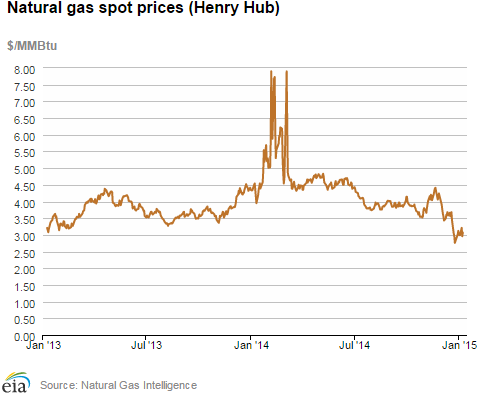
| Spot prices ($/MMBtu) | Thu, 1-Jan |
Fri, 2-Jan |
Mon, 5-Jan |
Tue, 6-Jan |
Wed, 7-Jan |
|---|---|---|---|---|---|
| Henry Hub | Holiday |
2.99 |
3.21 |
2.96 |
3.07 |
| New York | Holiday |
3.11 |
10.90 |
17.9 |
13.75 |
| Chicago | Holiday |
3.26 |
3.34 |
3.56 |
3.35 |
| Cal. comp. avg,* | Holiday |
3.20 |
3.30 |
3.06 |
3.14 |
| Futures ($/MMBtu) | |||||
| February contract | Holiday |
3.003 |
2.862 |
2.938 |
2.871 |
| March contract | Holiday |
2.999 |
2.875 |
2.924 |
2.865 |
| *Avg. of NGI's reported prices for: Malin, PG&E citygate, and Southern California Border Avg. | |||||
| Source: NGI's Daily Gas Price Index | |||||
| Spot prices ($/MMBtu) | Thu, 25-Dec |
Fri, 26-Dec |
Mon, 29-Dec |
Tue, 30-Dec |
Wed, 31-Dec |
|---|---|---|---|---|---|
| Henry Hub | Holiday |
Closed |
3.01 |
3.12 |
3.00 |
| New York | Holiday |
Closed |
3.29 |
3.45 |
3.16 |
| Chicago | Holiday |
Closed |
3.47 |
3.33 |
3.04 |
| Cal. comp. avg,* | Holiday |
Closed |
3.56 |
3.47 |
3.23 |
| Futures ($/MMBtu) | |||||
| January contract | Holiday |
Closed |
3.189 |
Expired |
Expired |
| February contract | Holiday |
Closed |
3.199 |
3.094 |
2.889 |
| March contract | Holiday |
Closed |
3.192 |
3.096 |
2.896 |
| *Avg. of NGI's reported prices for: Malin, PG&E citygate, and Southern California Border Avg. | |||||
| Source: NGI's Daily Gas Price Index | |||||
| Spot prices ($/MMBtu) | Thu, 18-Dec |
Fri, 19-Dec |
Mon, 22-Dec |
Tue, 23-Dec |
Wed, 24-Dec |
|---|---|---|---|---|---|
| Henry Hub | 3.68 |
3.44 |
3.04 |
2.97 |
2.76 |
| New York | 3.76 |
3.54 |
2.97 |
1.66 |
1.39 |
| Chicago | 3.77 |
3.47 |
3.00 |
2.92 |
2.82 |
| Cal. comp. avg,* | 3.78 |
3.46 |
2.93 |
2.82 |
2.72 |
| Futures ($/MMBtu) | |||||
| January contract | 3.642 |
3.464 |
3.144 |
3.171 |
3.030 |
| February contract | 3.676 |
3.498 |
3.180 |
3.204 |
3.072 |
| *Avg. of NGI's reported prices for: Malin, PG&E citygate, and Southern California Border Avg. | |||||
| Source: NGI's Daily Gas Price Index | |||||
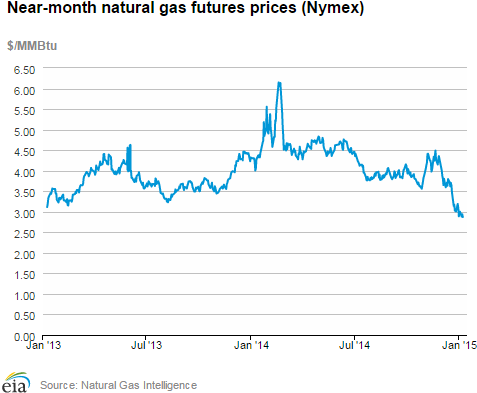
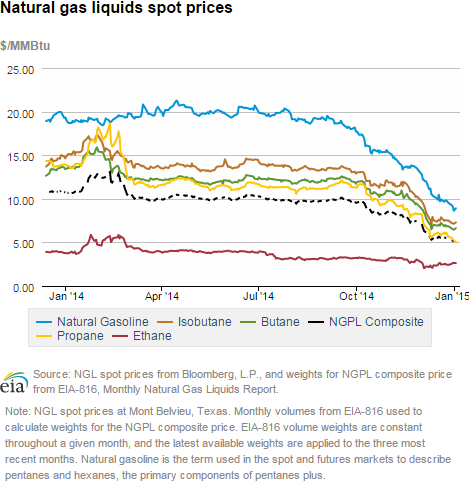
| U.S. Natural Gas Supply - Gas Week: (1/1/15 - 1/7/15) | ||
|---|---|---|
Percent change for week compared with: |
||
last year |
last week |
|
| Gross Production | 9.74%
|
-2.73%
|
| Dry Production | 9.65%
|
-2.71%
|
| Canadian Imports | -8.93%
|
21.95%
|
| West (Net) | 4.11%
|
3.71%
|
| MidWest (Net) | -14.38%
|
29.42%
|
| Northeast (Net) | -22.62%
|
77.68%
|
| LNG Imports | 52.23%
|
606.03%
|
| Total Supply | 7.93%
|
-0.46%
|
| Source: BENTEK Energy LLC | ||
| U.S. Consumption - Gas Week: (1/1/15 - 1/7/15) | ||
|---|---|---|
Percent change for week compared with: |
||
last year |
last week |
|
| U.S. Consumption | -8.8%
|
15.5%
|
| Power | -0.5%
|
21.2%
|
| Industrial | -1.8%
|
2.8%
|
| Residential/Commercial | -14.6%
|
19.3%
|
| Total Demand | -8.5%
|
15.7%
|
| Source: BENTEK Energy LLC | ||
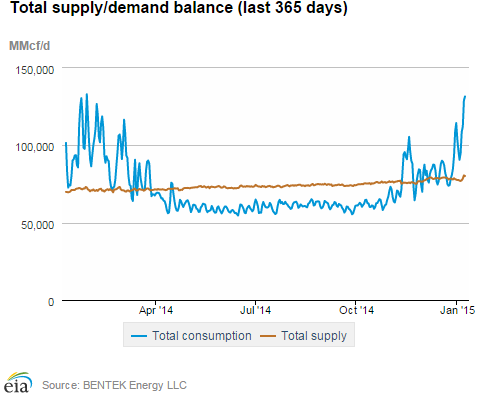
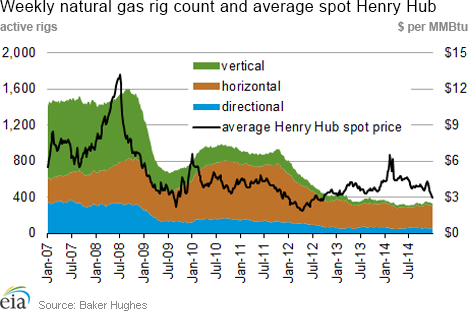
| Rigs | |||
|---|---|---|---|
Fri, January 02, 2015 |
Change from |
||
last week |
last year |
||
| Oil Rigs | 1,546 |
-1.84% |
9.57% |
| Natural Gas Rigs | 346 |
0.58% |
-6.23% |
| Miscellaneous | 1 |
0.00% |
-50.00% |
| Rig Numbers by Type | |||
|---|---|---|---|
Fri, January 02, 2015 |
Change from |
||
last week |
last year |
||
| Vertical | 330 |
-6.78% |
-18.92% |
| Horizontal | 1,367 |
-0.07% |
19.39% |
| Directional | 196 |
-1.01% |
-14.78% |
| Source: Baker Hughes Inc. | |||
| Working Gas in Underground Storage | ||||
|---|---|---|---|---|
Stocks billion cubic feet (bcf) |
||||
| Region | 2015-01-02 |
2014-12-26 |
change |
|
| East | 1,595 |
1,660 |
-65 |
|
| West | 428 |
461 |
-33 |
|
| Producing | 1,066 |
1,099 |
-33 |
|
| Total | 3,089 |
3,220 |
-131 |
|
| Source: U.S. Energy Information Administration | ||||
| Working Gas in Underground Storage | |||||
|---|---|---|---|---|---|
Historical Comparisons |
|||||
Year ago (1/2/14) |
5-year average (2010-2014) |
||||
| Region | Stocks (Bcf) |
% change |
Stocks (Bcf) |
% change |
|
| East | 1,417 |
12.6 |
1,631 |
-2.2 |
|
| West | 397 |
7.8 |
435 |
-1.6 |
|
| Producing | 1,025 |
4.0 |
1,090 |
-2.2 |
|
| Total | 2,839 |
8.8 |
3,156 |
-2.1 |
|
| Source: U.S. Energy Information Administration | |||||
| Temperature -- Heating & Cooling Degree Days (week ending Jan 01) | ||||||||
|---|---|---|---|---|---|---|---|---|
HDD deviation from: |
CDD deviation from: |
|||||||
| Region | HDD Current |
normal |
last year |
CDD Current |
normal |
last year |
||
| New England | 226
|
-36
|
-35
|
0
|
0
|
0
|
||
| Middle Atlantic | 213
|
-36
|
-24
|
0
|
0
|
0
|
||
| E N Central | 258
|
-26
|
-24
|
0
|
0
|
0
|
||
| W N Central | 316
|
7
|
0
|
0
|
0
|
0
|
||
| South Atlantic | 143
|
-33
|
-20
|
10
|
3
|
1
|
||
| E S Central | 166
|
-17
|
-21
|
0
|
-1
|
0
|
||
| W S Central | 152
|
15
|
2
|
0
|
-2
|
0
|
||
| Mountain | 298
|
62
|
87
|
0
|
0
|
0
|
||
| Pacific | 156
|
30
|
71
|
0
|
0
|
0
|
||
| United States | 214
|
-5
|
5
|
2
|
1
|
0
|
||
|
Note: HDD = heating degree-day; CDD = cooling degree-day Source: National Oceanic and Atmospheric Administration | ||||||||
Average temperature (°F)
7-Day Mean ending Jan 01, 2015
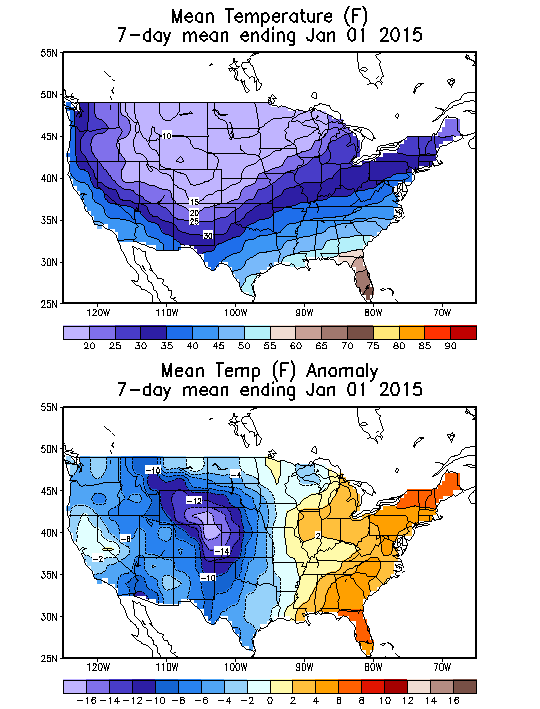
Source: NOAA/National Weather Service
Deviation between average and normal (°F)
7-Day Mean ending Jan 01, 2015

Source: NOAA/National Weather Service

